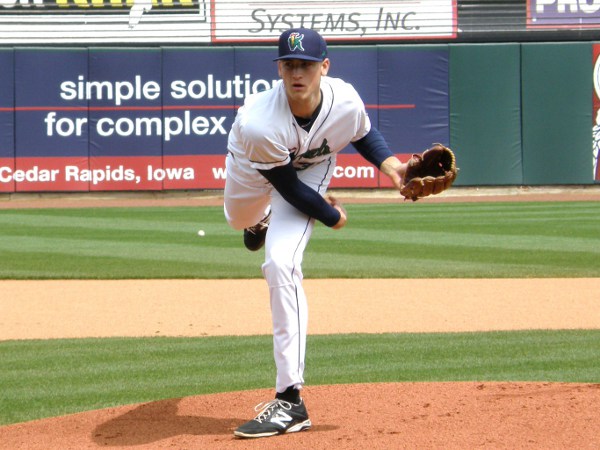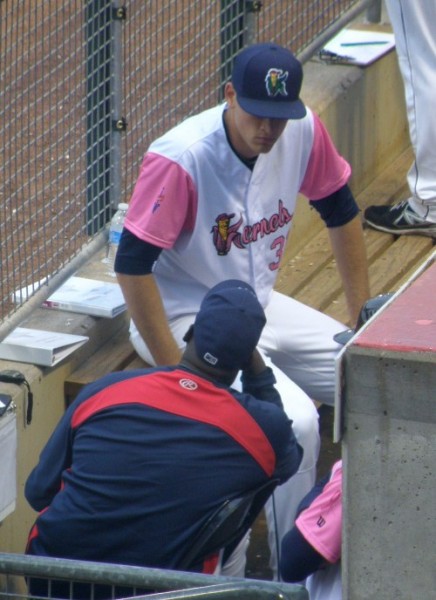The Cedar Rapids Kernels brought a highly heralded group of pitchers north out of spring training. The opening day pitching staff was littered with highly rated prospects obtained with high draft picks and big-money international free agency signings.
Even among top prospects, however, you’re never sure what kind of start you’ll get in a Midwest League season. Some of these pitchers are still teenagers. Some are a long way away from home for the first time. Some have seldom, if ever, pitched in front of a sizable crowd. Some have never experienced the kind of bone-chilling spring weather that is commonplace in Cedar Rapids and other MWL locations.
Any of those factors can cause a pitcher to get off to a slow start, but if you can find a guy who’s already spent a few years away from home, matured as a pitcher, pitched in high-pressure situations and is no stranger to cold weather, he just might have a chance to impress early.
But where could you possibly find such a pitcher? Maybe a guy whose spent the last three years away from home at college, pitching in front of big crowds in big games, regularly played in cold weather, during his college years.
Meet Kernels starting pitcher Aaron Slegers.

The 21 year-old Slegers, who was selected by the Minnesota Twins in the fifth round of the 2013 Major League June Amateur Draft out of the University of Indiana, is 3-0 for the Kernels and carries a 2.52 ERA after six starts. He’s struck out 33 batters in 35.2 innings, while walking just six.
Slegers threw seven shutout innings on Saturday night against the Peoria Chiefs and sat down for an interview the following morning.
Slegers is mature and converses his way through an interview easily, despite the fact that he must know, by now, that the first question every interviewer is going to start with will be about his height. At 6′ 10”, it’s impossible to overlook the obvious.

As he told a group of Kernels boosters at the club’s welcome dinner the day before the season started, he’s not even the tallest member of his family.
“My dad’s seven feet tall,” he said on Sunday, just as he told the gathering a month ago.
So there was never much doubt that the pitcher would be long in the frame.
“Yeah, there’s a funny story about that,” offered Slegers. “In the Big Ten Tournament at Target Field, my mom was interviewed by the Big Ten Network and the sideline reporter asked her, ‘when did you know Aaron was going to be so tall?’ She thought to herself, ‘I guess when I married a seven foot guy.’ I don’t think she said that to the reporter, though.”
Too bad. It’s the kind of line reporters love.
He also has an older sister, in New York City. “She’s about six foot, 6’ 1”. She played volleyball in college,” said Slegers.
Height can be an advantage for a pitcher, but it can also come with certain challenges, including additional levels of stress and strain on important joints.
Slegers fought through a number of injuries in college, but he doesn’t feel they were related to his height.
“The injuries were kind of freak, they weren’t really related to growing or anything,” Slegers explained. “I took a line drive my freshman year in an intrasquad the first week of the season. The first pitch I threw to our starting shortstop that year was a fastball right down the middle and he hit it right back at me off my throwing wrist. That broke my wrist and I was out for the year on a medical redshirt.
“The next year, was a little more my fault, but I showed up a minute late for the bus that was leaving the hotel for the field and the punishment for that was running the entire batting practice. Because of that, I got shinsplints in my right shin. It hurt to walk and, again, out for the year after seven innings my sophomore year.
“It was a tough little stretch there when I was in Indiana the first couple of years. It was a tough go on the injuries.”
Things got better before he left Bloomington, however.Slegers and his Indiana teammates made it all the way to the College World Series in Omaha last year. Slegers threw a complete game in his final appearance as a Hoosier, but lost to Oregon State 1-0.
Despite the way it ended, the trip made all of the early challenges at Indiana worthwhile.
“A hundred percent, exactly right,” Slegers agreed, smiling. “The College World Series makes everything OK.”
The sight of a 6′ 10” pitcher on the mound brings to mind memories of Randy Johnson, the certain future Hall of Fame pitcher who’s fastball periodically clocked in excess of 100 miles per hour.
But that’s not Slegers’ style. His fastball regularly sits in the low 90s, which is good, but not considered overpowering.
The big righthander isn’t concerned about his velocity, however.
“Velocity’s always nice, but that’s sort of something that comes secondary,” explained Slegers.
The primary thing, according to Slegers, is getting the preparation work done and preparing to compete.

“Working in the bullpen, working on your mechanics, long-toss. When you go out and compete, you’re doing exactly that. Going out and competing, trying to repeat (the delivery) and throw strikes and throw all your pitches for strikes. Velocity’s just sort of one of those things that happens.”
So you won’t see Slegers turning around to check his pitch speed on the Kernels’ video board after every pitch.
“That’s something they’re trying to steer us away from,” Slegers agreed, smiling.
Slegers saw a lot of success in college, but he realizes he’s working at a new level now and that requires work to improve, even if he’s not focused on adding velocity to his fastball right now.
“I’m throwing my slider and change up more since I got in pro ball; trying to keep the hitters off balance. You can’t just keep pumping in fastballs over and over. They’re pretty good at learning those pitches. I’m kind of moving the baseball more than in college.”
One thing Slegers hasn’t had to do is adjust to pitching in cold Midwestern weather. His time pitching in the Big Ten assured he’d be prepared for that aspect of his first full season of professional ball.
“Oh yeah, oh yeah,” said a smiling Slegers. “We would go down south the whole month of February, but when we’d come up to school, if it was above 35, we were out on the field practicing and trying to hit BP So, yeah, I’m more than accustomed to it. And those late March home games will toughen you up in a hurry, in terms of the weather.”
Being accustomed to cold weather doesn’t mean he spends any more time in it than he has to, however.
Slegers may have gone to school in Indiana, but he and his family live in Arizona and that’s where he spends his offseason.
Slegers stays active both in the offseason and, to the degree possible, during off days during the season.
“I like to fish and golf, primarily,” Slegers said, concerning his off-the-field interests. “I like to golf as much as possible. In terms of exercising, I like cycling, road biking. That always takes up my time when I want a good cardio workout. It’s kind of unusual for a guy my size to ride a road bike, but mostly golf and fishing are my relaxing offday hobbies.”
– JC
